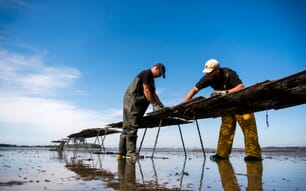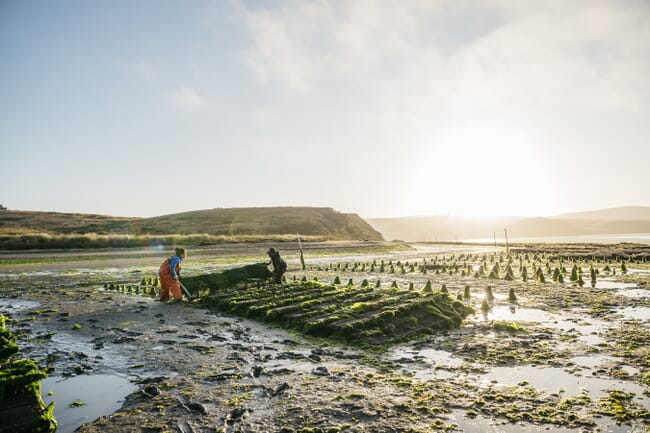
© Remy Hale
Enjoyed at raw bars across the world with a squeeze of lemon, nearly every farmed oyster starts its journey the same way: in a hatchery.
“When hatcheries make baby oysters they start with the moms and pops and they end up with billions of tiny, microscopic oyster larvae that hang out in suspension for a couple of weeks in the seawater, feeding on phytoplankton,” explains Gary Fleener, a scientist-turned-director at Hog Island Oyster Co. Based in California, Hog Island is one of the largest oyster businesses in the US – operating five restaurants, selling wholesale and shipping its oysters directly to homes across the country via their website.
This method of spawning oysters in tanks that are aerated with a mix of fresh seawater and oxygen is similar across the world and is why farmed oysters have a 71 percent higher survival rate than their wild counterparts: hatcheries work.
But in 2007, west coast hatcheries in the United States were shaken. From Washington State to California, entire generations of larvae were dying. And hatchery technicians couldn’t figure out why it was happening. That year, most west coast oyster farmers were left without any seed for their upcoming season.
Describing it as “series of fairly catastrophic die-offs of larvae,” Fleener says that “the complete die off… was a little bit baffling.” At first, hatcheries thought that it was a bacterial outbreak but it turned out to be a product of increased ocean acidity or declining ocean pH. Upwellings of deep ocean water with a pH of 7.8 were too acidic for the oyster larvae. Surface ocean pH is typically above 8.0. Although it was a small difference in alkalinity, for larvae working to create shells, it was too great.
“It ended up serving as a foreshadowing of… [what] the future might do to the shellfish industry,” says Fleener. “The waters that were upwelling at the time that killed all those larvae are what they model for 50 years down the road.”
“Ocean acidification impacts the ability of organisms like oysters, mussels and clams to build shells,” explains Dr Tessa Hill, author of At Every Depth: Our Growing Knowledge of the Changing Oceans and professor at University of California Davis. Dr Hill studies the increasing threat of ocean acidication to see if eelgrass or seaweed can help mitigate the changes and conducts some of her field work near one of Hog Island‘s oyster farms.
“The changes in ocean chemistry associative with rising human-caused carbon dioxide emissions actually change the building blocks that organisms use to make their shells. We’ve seen evidence of smaller, weaker shells in animals such as oysters and mussels,” she explains.
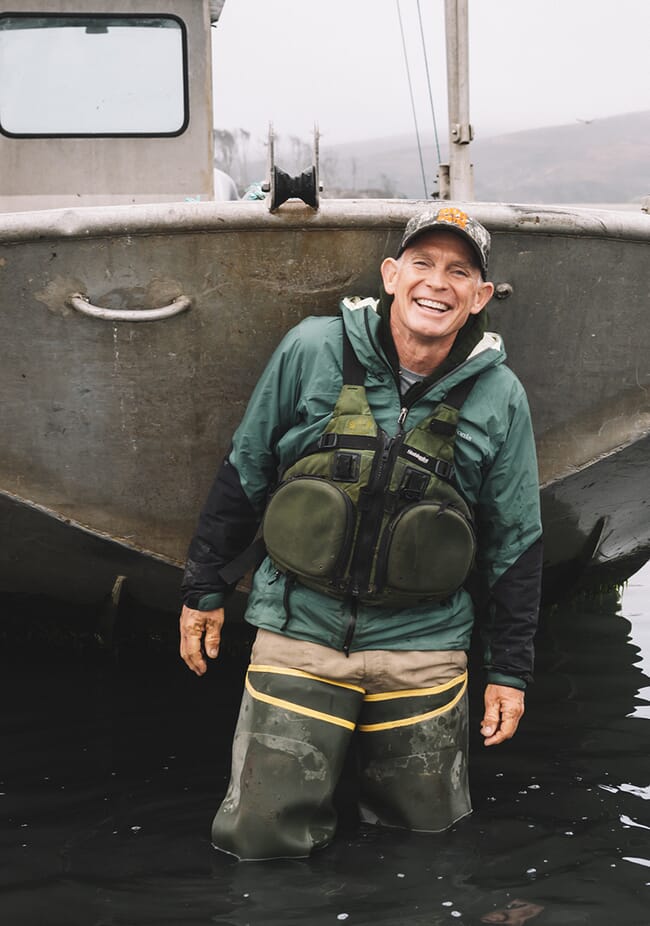
© Hog Island Oyster Co
After the die-off, Hog Island invested in building their own hatchery and created a vertically integrated business, a move that they say has helped them become one of the country’s most successful oyster businesses. By 2012, they had acquired a seawater pumping permit from the California Coastal Commission and now mix their intake ocean water with ash, to make it more alkaline and ensure that the larvae oysters are not damaged by declining ocean pH.
Although hatcheries and farmers figured out a workaround, the event sparked many questions for marine scientists and ocean observers. If farmed larvae were struggling under these new conditions, what did it mean for wild species?
“The ocean is a powerful ally in the climate crisis, absorbing carbon dioxide from the atmosphere. This critical service comes at a cost—the ocean's chemistry is changing and the US west coast is especially vulnerable,” says Alex Harper, deputy director of The Central & Northern California Ocean Observing System (CeNCOOS), a regional component of the US Integrated Ocean Observing System (US IOOS). The group gathers ocean chemistry data from a network of monitoring stations off the coast of California and makes them available to the public, via the new California OAH Portal.
“CeNCOOS data have shown that ocean acidification is occurring off the west coast at an accelerated pace, forcing business and communities to adapt quickly,” says Harper. “Shellfish growers were some of the first to develop methods to mitigate the impacts of ocean acidification by implementing local monitoring strategies and applying alkaline substances to seawater in their farms.”
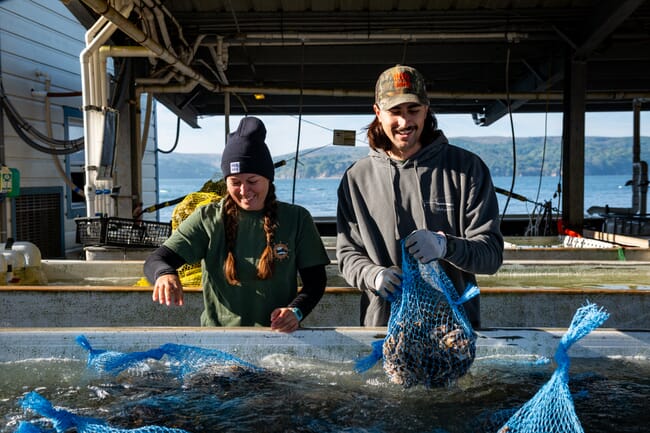
Describing ocean acidification as one of “the most daunting challenges,” Bill Dewey, director of public affairs at Taylor Shellfish Farms in Washington State remembers the mass larval die-offs. From 2007-2009 the company was experiencing 75 percent mortality of their oyster larvae at their Dabob Bay, Washington hatchery. Although they were able to increase production at their hatchery in Kona, Hawaii, to offset the west coast’s losses, they were gravely concerned about what the impacts of ocean acidification could mean for shellfish growers in the future – including themselves.
Now, they focus part of their business on educating the public, as well as policy makers and NGOs around the impact of carbon pollution and how to decrease carbon emissions, as well as research different ways that their farm can adapt to changing ocean conditions. Dewey says that “some of those adaptations include breeding oysters that can tolerate the changes, looking to bays with abundant seagrasses such as Samish and Willapa as natural refuges for shellfish culture in the future, co-culturing seaweed with shellfish and considering culturing alternative species [such as seaweeds] that are less vulnerable or more able to adapt.”
Although the west coast of the US first experienced this phenomena, marine scientists now warn that the same thing could happen in areas like New England. The Gulf of Maine is warming 99 percent faster than any other body of water and is also threatened by increasing acidification. Shellfish farmers there are working with scientists to see if co-growing seaweed and shellfish in halo-shaped farms can help the shellfish to grow thicker shells despite the decreasing pH.
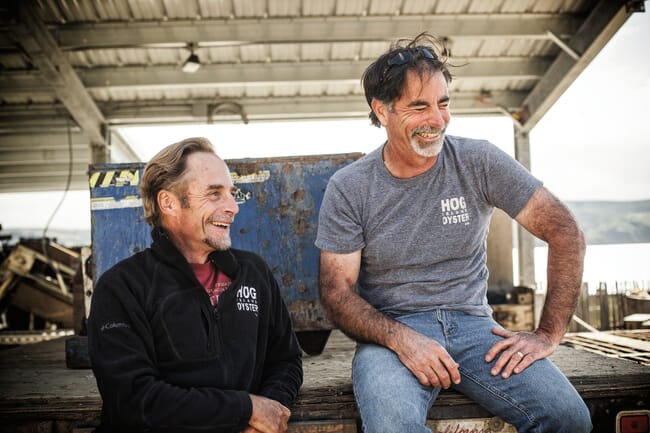
© Hog Island Oyster Co
“The astute grower must always consider the potential for storms and storm damage, harmful algal blooms and/or disease. Any and all of these issues can arise at any moment,” says Barley Dunne, owner of Shellworks in New York. Dunne, who also works as the East Hampton Shellfish hatchery director, says the threat of ocean acidification is less immediate for Long Island growers, but that farms further north across New England are already adapting their hatchery practices.
Pointing out that oysters have been on the planet for millions of years, Fleener says that, “they've lived through lots of climatic changes. Some of them probably still have that resilience in their genomes.” Given the current state of the ocean, he believes that there is a potential for breeding oysters with an ocean acidification resilience in the future.
“The time to start thinking about adaptation and resiliency is now,” he concludes.


